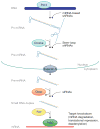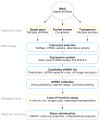Stable RNA interference rules for silencing
- PMID: 24366030
- PMCID: PMC4001088
- DOI: 10.1038/ncb2895
Stable RNA interference rules for silencing
Abstract
RNA interference has become an indispensable tool for loss-of-function studies across eukaryotes. By enabling stable and reversible gene silencing, shRNAs provide a means to study long-term phenotypes, perform pool-based forward genetic screens and examine the consequences of temporary target inhibition in vivo. However, efficient implementation in vertebrate systems has been hindered by technical difficulties affecting potency and specificity. Focusing on these issues, we analyse current strategies to obtain maximal knockdown with minimal off-target effects.
Conflict of interest statement
C.F. and S.W.L. are founders of Mirimus Inc., and C.F. is an employee of Mirimus Inc., a company that has licensed some of the shRNA technology discussed in this work.
Figures




References
-
- Hopkins AL, Groom CR. The druggable genome. Nat Rev Drug Discov. 2002;1:727–730. - PubMed
-
- Bartel DP. MicroRNAs: Genomics, biogenesis, mechanism, and function. Cell. 2004;116:281–297. - PubMed
-
- Hannon GJ. RNA interference. Nature. 2002;418:244–251. - PubMed
-
- Filipowicz W, Bhattacharyya SN, Sonenberg N. Mechanisms of post-transcriptional regulation by microRNAs: are the answers in sight? Nat Rev Genet. 2008;9:102–114. - PubMed
Publication types
MeSH terms
Substances
Grants and funding
LinkOut - more resources
Full Text Sources
Other Literature Sources

